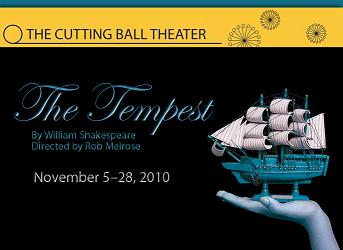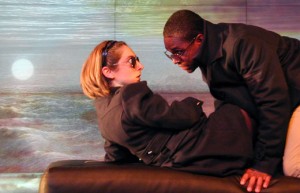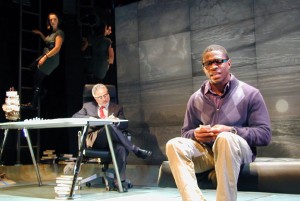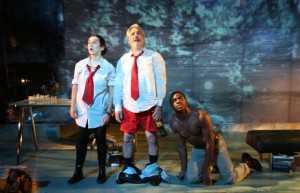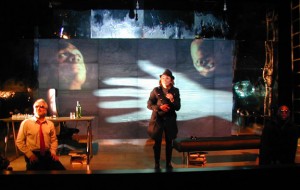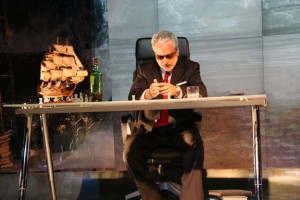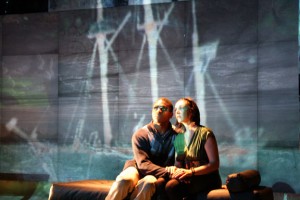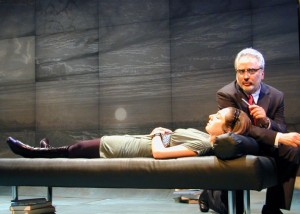A TEMPEST OF IMAGINATION
Many productions of Shakespeare’s works pass themselves off as inventive merely because the setting is New York instead of Verona, or Renaissance costumes are swapped for Art Deco – rarely do these stylistic changes improve the psychology of the piece. When it came to my attention that The Tempest was to be done in a psychiatrist’s office, using multi-media and only three actors, I balked at the possibility of a fresh enhancement to the Bard’s tale of sorcery, revenge, monsters, and romance.
It is a delight to report that there is a theatrical marvel in store for you: Cutting Ball Artistic Director (and co-founder) Rob Melrose has gone well beyond a mere modern interpretation – he has re-envisioned The Tempest as an avant-garde dream; one which elucidates the psychological complexities of Shakespeare in such a way that theatre never seemed so alive, intimate, accessible, extraordinary and (by no means an understatement) brilliant. What makes it even more astonishing is that he uses only three actors to play all of the roles.
Some wonder why this show has the title it does when a storm only appears once at the top of Act I – Melrose has us understanding that the title refers to the gale of torment that ravages a soul when one is incapable of forgiveness. In this instance, the tormented soul is the exiled Duke of Milan, Prospero (David Sinaiko), who dwells on an island with his daughter Miranda (Caitlyn Louchard), his servant, Caliban (Donell Hill), and his captive sprite Ariel (also Miss Louchard).
As fate would have it, a ship comes along carrying King Alonso of Naples (Mr. Sinaiko) and his entourage, who are returning home from the wedding of the King’s daughter in Tunis. Prospero’s brother Antonio (Mr. Hill), the one responsible for usurping him as Duke – and sending him off to die at sea – is sailing home with the King, who had helped remove Prospero from power. Sorcerer Prospero conjures up a storm that shipwrecks them on the island. The King’s son, Ferdinand (Mr. Hill), convinced that he alone endured the tempest, finds solace when he falls in love with Miranda (a scheme cooked up by Prospero).
Also surviving the wreck is the jester Trinculo (Miss Louchard) and a butler Stephano (Mr. Sinaiko); they encounter Caliban, who (with a fair amount of wine) convinces them to assassinate Prospero. Hoping to take over the island (and Miranda), Stephano agrees.
That three performers can switch between roles so effortlessly is one thing, but the gut-wrenching laughter elicited from the audience during the Trinculo/Stephano/ Caliban scenes is a testament to comic interpretation; the company takes risks with Shakespeare’s words and the payoff is inspiring – every pause, every look is well-timed and character-driven. (Later, the clever decision was made to have Ferdinand and Miranda nearly French kiss each other while Prospero lectures them, which adds a new meaning to his, “No tongue; all eyes”; the moment is hysterical, but instead of feeling bawdy and cheap, it just further establishes Prospero as a curmudgeonly controller.)
The innovative genius is apparent from the start: a woman lies supine on a couch in a psychiatrist’s office that appears to be in the bottom of a pool (credit Michael Locher with that stunning, avant-garde set design); she suddenly breaks from her trance with a scream, and the theatre comes alive with a multi-media storm. A grey-haired man sits behind a desk holding onto a model ship and bobs it to and fro with his hands, while a shirtless man hangs from a steel pool ladder, as if on a mast. At once, Mr. Sinaiko is Prospero controlling the boat, but the dialogue is that of Alonzo on the ship during Scene I.
Then, the woman (who had been shouting out dialogue during the storm) collapses on the couch in the therapist’s office, as if she is going back under a hypnotic spell. It is now Scene II, and the woman is Miranda, who has witnessed the shipwreck; she says, “O, I have suffer’d with those that I saw suffer.” The therapist is now Prospero who speaks in a soothing tone while he cradles his daughter, as if he were explaining nightmarish visions that came to her while she was hypnotized. Once Prospero elucidates who these shipwrecked visitors to the island are, he waves a hand before her eyes and she faints under his spell.
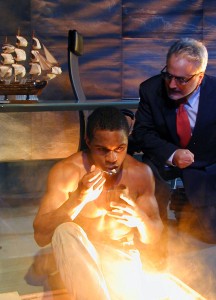 The next moment is breathtaking: Prospero calls to his faithful sprite, Ariel, and Miss Louchard, who just went under as Miranda, now opens her eyes as Ariel; the transformation is aided with an exquisite change in lighting (Heather Basarab) and an echo added to the sound (Cliff Caruthers). The entire effect is astounding because it immediately establishes Prospero as the father with influence and Miranda as the manipulated daughter who falls in love at first sight with the handsome, muscular Ferdinand.
The next moment is breathtaking: Prospero calls to his faithful sprite, Ariel, and Miss Louchard, who just went under as Miranda, now opens her eyes as Ariel; the transformation is aided with an exquisite change in lighting (Heather Basarab) and an echo added to the sound (Cliff Caruthers). The entire effect is astounding because it immediately establishes Prospero as the father with influence and Miranda as the manipulated daughter who falls in love at first sight with the handsome, muscular Ferdinand.
Thus, Melrose’s raison d’etre is established: we have three main characters – Prospero, Miranda, and Ferdinand; therefore, only three actors are needed. The others in the script are all ASPECTS of these three main characters, adding a Freudian and Jungian layer which makes the setting of an analyst’s office no mere device – it’s a mastermind of an idea fully realized. There are a lot of magical goings on in the text which can now be explained logically as emanations from the subconscious dream world of the characters’ minds.
Cliff Caruthers’ evocatively disturbing music (reminiscent of Twin Peaks), video installations and masterful sound design are perfect examples of technology that enrich storytelling (versus technology in lieu of a good story). If you’ve been looking for a way to introduce Shakespeare to the younger generation, this is it – they will love the multi-media effects.
Although Rob Melrose is a true visionary of the theater, this subtext may not be coherent to the untrained eye – indeed, there may be moments of murkiness and confusion for some (especially toward the end when the cast of 3 handles 12 roles at once!). It may have helped if Melrose had allowed Mr. Sinaiko, and especially Mr. Hill, to create characters that are more acutely differentiated, both physically and vocally. There was no mistaking Miss Louchard’s distinct characterizations (and she has a magnificent singing voice as well).
Maybe you will want a repeat viewing after you go home and study the text: Just as miraculous as the production is this news — for one extraordinarily inexpensive season ticket, you can see all of the Cutting Ball’s shows as many times as you’d like. It is this offer, combined with an astonishingly magical production, which makes it a true privilege to know about this company.
photos by Rob Melrose
The Tempest
Cutting Ball Theater
Exit Theater, 277 Taylor St
ends on November 28, 2010 EXTENDED to December 19, 2010
for tickets, call 800.838.3006 or visit Cutting Ball
